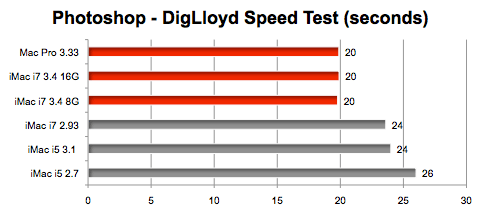PRO APP SHOOTOUT:
2011 Core i5 iMacs versus Core i7
Posted Friday, June 17th, 2011, by rob-ART morgan, mad scientist
In an earlier article, we compared the top 'early 2011' iMac to the top 2011 MacBook Pro, top 2010 iMac, and popular 6-core 2010 Mac Pro running four pro apps and one "not-so-pro" app. Some of you were curious if the top 2011 iMac 3.4GHz Core i7 was significantly faster than the 2011 Core i5 models when running similar apps. Here's your answer.
Adobe After Effects CS5.5, used for creating motion graphics and cinematic effects, lets you assign a dedicated amount of RAM to each virtual core when you enable multiprocessing mode for rendering. The more memory you have, the more cores can be used to render the project. There is a sweet spot to be found by trying different combinations of RAM per core. (Time is in seconds. Smaller numbers are better. RED bar indicates the fastest Mac.)

Adobe Photoshop CS5.5 uses multiple cores but not all available cores. We observed the 2011 iMac using from two to five cores (out of eight virtual possible) when running Lloyd Chamber's diglloydSpeed1 action file for speed testing. (Time is in seconds. Smaller numbers are better. RED bar indicates the fastest Mac.)

HandBrake was used to convert a 2.3 min HD video to iPad format (using iPad preset in the latest version). (Time is in seconds. Smaller numbers are better. RED bar indicates the fastest Mac.)

Apple's iTunes isn't a pro app but is an interesting excercise in that it uses only one core to convert MP3 to AAC. We converted 14 tunes (totalling 34 min and 18 secs). Note the surprise winner. Can you say "Turbo Boost" boys and girls? (Time is in seconds. Smaller numbers are better. RED bar indicates the fastest iMac.)

GRAPH LEGEND
Mac Pro 3.33 = 'mid 2010' Mac Pro 3.33GHz 6-Core Westmere with 16G of RAM
iMac 3.4 16G = 'mid 2011' iMac 3.4GHz Core i7 with 16G of RAM
iMac 3.4 8G = 'mid 2011' iMac 3.4GHz Core i7 with 8G of RAM
iMac 2.93 = 'mid 2010' iMac 2.93GHz Core i7 with 8G of RAM
iMac i5 3.1 = 'mid 2011' iMac 3.1GHz Core i5 with 8G of RAM
iMac i5 2.7 = 'mid 2011' iMac 2.7GHz Core i5 with 8G of RAM
INSIGHTS
The CTO 3.4GHz Core i7 iMac is clearly faster than its Core i5 siblings running pro apps that use multiple cores. In the case of Photoshop, the 4-core 3.4GHz iMac tied the 6-core Mac Pro. That's because the filters and functions used in the Photoshop test never use more than 5 cores. However, After Effects and Handbrake use all available cores.
One publication mistakingly deemed the 3.4GHz iMac the "fastest Mac." Based on our tests of real world apps on this page along with various benchmarks and games, it's clear the Mac Pro is still the fastest Mac. However, it is correct to call the CTO 3.4GHz iMac the "fastest iMac."
In the case of the one "non-so-pro" app, iTunes, the 2.7GHz Core i5 iMac beat the 3.1GHz Core i5 and equaled the iMac 3.4GHz Core i7. That is explained by Turbo Boost. When only one core is in use (as in the case of iTunes), the 2.7GHz Core i5's core frequency jumps up to 3.7GHz. The 3.1GHz Core i5 only clocks to 3.4GHz. The Core i7 3.4GHz only bumps to 3.8GHz.
One factor is consider in choosing a Mac is cost/performance equation. For example, the base 3.1GHz Core i5 (27") iMac costs 18% more than the 2.7GHz Core i5 (27")iMac . When rendering a project in After Effects, the 3.1GHz iMac is 10% faster. When running the iTunes conversion, the 2.7GHz iMac is 8% faster. If you stop there, the 2.7GHz Core i5 appears to have the best bang for the buck. But if you are a gamer, the 3.1GHz Core i5 (with Radeon 6870M) is as much as 87% faster than the 2.7GHz Core i5 (with Radeon 6770M) running games like Portal 2. That's why when readers ask me for purchase advice, I respond with the question, "What are the three most demanding apps you run?"
Finally, I advise you to avoid the temptation of short changing yourself on memory. The graph below illustrates how just going from 4G to 8G of RAM you can speed up the After Effects render by 13%.

Also consult the online manual for your model of Mac to be sure you configure the memory correctly. Putting the memory modules in the wrong location can cut your memory transfer speed in half.
Big mahalo to the OWC Lab for testing the Core i5 iMacs for us. To be notified of new test results, subscribe to our RSS feed or follow us on Twitter@barefeats.
WHERE TO BUY APPLE PRODUCTS
When you purchase Apple USA products, please CLICK THIS LINK or any APPLE BANNERS on this site. It's a great way to support Bare Feats. since we earn a commission on each click-through that results in a sale.